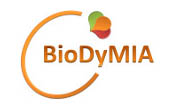2013 (11) : "Lactic acid bacteria strains for bioprotection application with cells entrapment in biopolymeric matrices"(Thesis by Lucie LEONARD)
- Thesis start date: October 1, 2010
- Defended on: Thursday, November 14, 2013 at AgroSup Dijon
- PhD student: Lucie LEONARD
- Thesis directors: Nadia OULAHAL (BioDyMIA, Lyon1), Rémi SAUREL (PAPC, UMR PAM, Agrosup’Dijon, uB)
Subject presentation:
This thesis (co-supervised) took place in two research units over 18 months on both sides:
- BioDyMIA (Bioengineering and Microbial Dynamics at Food Interfaces), Lyon1 - Isara and PAPC Team (UMR PAM),
- Agrosup’Dijon, University of Burgundy.
The objectives of the thesis and the methodology selected were divided into 5 parts:
- Part 1: Selection of strains of lactic bacteria (LAB) according to their antimicrobial properties
- Part 2: Implementation of the two-phase mixture of thermodynamically incompatible Na-Alginate / Na-Caseinate
- Part 3: Viability of immobilized LAB cells according to the storage conditions of the matrix
- Part 4: Impact of immobilization of LAB cells on the physicochemical properties of the matrix
- Part 5: Antimicrobial efficacy of the matrix against Listeria
Technical means
- Biopolymers used: water-in-water emulsion of sodium caseinate and sodium alginate (multiphase system)
- Microorganisms of interest: lactic acid bacteria (example Lactococcus lactis)
- Target bacteria: Listeria spp.
- Methods used: - Determination of antimicrobial activity (well diffusion method on agar medium, treatment with Bioscreen® (liquid medium);-Gelation of the matrix by addition of calcium (bead formation using the “Nisco encapsulation unit VarV1 LIN-0119 (Nisco Engineering AG, Zurich, Switzerland)” encapsulator and “flat gel” formation);
- Exclusion chromatography; SDS-Page electrophoresis; epifluorescence microscopy (Axiovert 25 CFL, Carl Zeiss, Iena, Germany)
Other
Thesis that is part of the project: "Microbes in confined environments_Application to bioprotective packaging" (2010-2013)
cofinanced by “Alimentec Technopole Research Development Fund” and the Burgundy Region (PARI Agrale N ° 3 “Matbio Vectorisation”)
Project partners:
PAPC (UMR PAM) -AgroSup Dijon- University of Burgundy,
Gpack company-St Martin du Fresne,
Actilait (Technical center dedicated to milk and dairy products) -Bourg en Bresse,
Technical Center for the Conservation of Agricultural Products (CTCPA) -Bourg en Bresse
Technopole Alimentec-Bourg en Bresse.
Valorization:
This work has so far been the subject of 2 publications in international journals:
- Léonard et al. (2013) Colloids and Surfaces B: Biointerfaces, 109, 266-272
- Léonard et al. (2014) Food Control, 37, 200-209
and 5 papers in national and international congresses.
Summary:
Among the various methods to control foodborne pathogenic and/or food spoilage microorganisms in food chain, bioprotective lactic acid bacteria (LAB) appear to be promising tools for food biopreservation. This collaborative study, between PAPC (Agrosup Dijon, University of Burgundy) and BioDyMIA (University Lyon1-Lyon Isara) laboratories, concerned the development of sodium alginate/sodium caseinate polymeric matrices intended to entrap LAB cells selected for their anti-Listeria spp. activity. First, 4 LAB strains from 19 LAB strains were selected for their anti-Listeria spp. activity: this screening was performed by the method of agar diffusion against three Listeria spp strains. Then, antimicrobial metabolites produced by the selected LAB strains were partially characterized by assessing the effect of various thermal and enzymatic treatments on the anti-Listeria spp. activity of their culture supernatants. A partial purification and identification of antimicrobial active peptides produced by the main strain of interest (Lactococcus lactis LAB3) was also performed. A composition of the polymer matrix has been selected by performing the phase diagram of sodium alginate/sodium caseinate system: 1.5% (w/w) sodium alginate / 4% (w/w) of caseinate sodium / 20% (w/w) MRS broth. This formulation provides a rich alginate continuous phase and a rich caseinate dispersed phase in which LAB cells localize according to the study by confocal microscopy. LAB cells were immobilized in liquid and gelled matrices of alginate and alginate/caseinate. Culturability and anti-Listeria activities were measured during a storage at 30°C for 12 days. The alginate/caseinate matrices were more effective in better maintaining LAB cells cultivability and their antimicrobial activity than alginate matrix. This effectiveness seemed correlated with cell viability and the dispersion-like structure of the protein-based system which enhance production and release of antimicrobial metabolites. Thus, this type of polymeric matrix appeared as a promising immobilization system of bioprotective LAB.



 en
en fr
fr